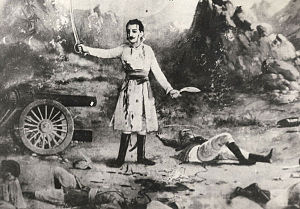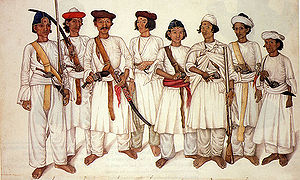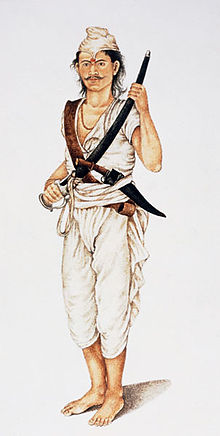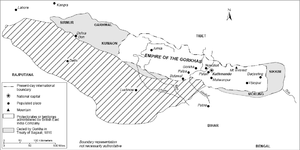- Anglo–Nepalese War
-
This article is about the Anglo-Nepalese War of the 1810s . For the Sino-Nepalese War of the 1790s, see Ten Great Campaigns.
Anglo-Nepalese War 
Balbhadra Kunwar, Gurkha commander of the Anglo-Nepalese WarDate 1814–1816 Location Nepal Result Treaty of Sugauli,territory under Nepal's control ceded to the British Belligerents  British East India Company
British East India Company
 Patiala State
Patiala State Kingdom of Nepal
Kingdom of NepalCommanders and leaders Francis Rawdon-Hastings
David Ochterlony
Rollo Gillespie†
Bennet Marley
John Sullivan WoodBhimsen Thapa
Amar Singh Thapa
Ranjur Singh Thapa
Bhakti Thapa†Strength 2,179 (First campaign)[1] 17,000 (Second campaign)[1]
12,000[citation needed] Casualties and losses Unknown Unknown The Gurkha War (1814–1816), sometimes called the Gorkha War or the Anglo–Nepalese War, was fought between the Kingdom of Nepal (now Federal Democratic Republic of Nepal) and the British East India Company as a result of border tensions and ambitious expansionism. The war ended with the signing of the Treaty of Sugauli in 1816, which ceded around a third of Nepal's territory to the British.
Contents
Historical background
The Shah era of Nepal began with the invasion of Kathmandu valley, which consisted of the capitals of Malla confederacy that ruled Nepal during the medieval era of Nepal.
In 1767, a request to the British for help by the Nepalese Malla confederacy under threat from Gorkha invasion resulted in an ill-equipped and ill-prepared expedition numbering 2,500 led by Captain Kinloch. The expedition was a disaster; the Gorkha army easily overpowered those who had not succumbed to malaria or desertion. This ineffectual British force provided the Gorkhas with firearms and filled them with suspicion, causing some to underestimate their future opponents.
The invasion of Nepal resulted with Gorkha kingdom being renamed as Nepal and the shift of the capital of the kingdom from Gorkha to Kathmandu. Also, the invasion of economically sound medieval Nepal provided the Gurkha army economic support for furthering their martial practices throughout the region. The martial campaign in eastern region was largely a failure. After a number of defeats by the Limbuwan army, the Gurkha army finally made peace treaty with Limbuwan and incorporated the Limbuwan states into Nepal under a mutual pact. In the west, all rulers as far as the Kali River had submitted or been replaced by 1790. Farther west still, the Kumaon region and its capital Almora had also succumbed to the Gorkhas.
To the north however, aggressive raids into Tibet (concerning a long-standing dispute over trade and control of the mountain passes) triggered the Chinese intervention. In 1792 the Qianlong Emperor sent an army, expelling the Nepalese from Tibet to within 5 km of their capital at Kathmandu. Acting regent Bahadur Shah, (Prithvi Naryan’s son), appealed to the British Governor-General of India, Francis Rawdon-Hastings, Lord Moira for help. Anxious to avoid confrontation with the Chinese, Lord Moira sent Captain Kirkpatrick as mediator, but before he arrived the war with China had finished. The Nepalese were forced into signing a humiliating treaty revoking their trading privileges in Tibet and requiring them to pay tribute to Peking every five years.
The Tibet affair had postponed a previously planned attack on the Garhwal Kingdom, but by 1803 Raja of Garhwal Pradyuman Shah had also been defeated. He was killed in the struggle in January 1804, and all his land annexed. Further west, general Amar Singh Thapa overran lands as far as the Kangra – the strongest fort in the hill region – and laid siege to it (although by 1809, Ranjit Singh the ruler of the Sikh state in the Punjab, had intervened and driven the Nepalese army east of the Sutlej river).
Dispute
The British were also expanding their sphere of influence at an alarming rate. The acquisition of the Nawab of Awadh's lands by the British East India Company brought the region of Gorakhpur into the close proximity of the raja of Palpa – the last remaining independent town within the Gorkha heartlands. Palpa and Butwal were originally two separate principalities; they were afterwards united under one independent Rajput prince, who, having conquered Butwal, added it to his hereditary possessions of Palpa. The lands of Butwal, though conquered and annexed, were yet held in fief, or paid an annual sum, first to Awadh, and afterwards, by transfer, to the British. During the regency of Rani Rajendra Laxmi, towards the close of the 18th century, the hill country of Palpa was conquered and annexed to Nepal. The rajah retreated to Butwal, but was subsequently induced, under false promises of redress, to visit Kathmandu, where he was put to death, and his territories in Butwal seized and occupied by the Gorkhas. [2]Bhimsen Thapa, the Nepalese prime minister from 1806 to 1837, installed his own father as governor of Palpa, leading to serious border disputes between the two powers. The "illegal" occupation from 1804 till 1812 to the Terai of Butwal by the Nepalese, which was under British protection, was the immediate reason which led to the Anglo-Nepal war in 1814.[2]
These disputes arose because there was no fixed boundary separating the Gorkhas and the British. A border commission imposed on Nepal by the Governor-General failed to solve the problem. Gorkha raids into the flatland's of the Terai, a much prized strip of fertile ground separating the Nepalese hill country from India, increased tensions – the British felt their power in the region and their tenuous lines of communication between Calcutta and the northwest were under threat. Since there was no clear border, confrontation between the powers was inevitable.
War
While the Gorkhas had been expanding their empire – into Sikkim in the east, Kumaon and Garhwal in the west and into the British sphere of influence in Oudh in the south – the British East India Company had consolidated its position in India from its main bases of Calcutta, Madras and Bombay. This British expansion had already been resisted in India, culminating in three Anglo-Maratha wars as well as in the Punjab where Ranjit Singh and the Sikh Empire had their own aspirations.
When the Kathmandu durbar solicited Gorkha chiefs’ opinions about a possible war with the British, Amar Singh was not alone in his opposition, declaring that – "They will not rest satisfied without establishing their own power and authority, and will unite with the hill rajas, whom we have dispossessed." This contrasts sharply with the prime minister Bhimsen Thapa – " ... our hills and fastness are formed by the hand of God, and are impregnable." The Gorkha prime minister realized the Nepalese had several advantages over the British including knowledge of the region and recent experience fighting in the mountainous terrain. However, the British had numerical superiority and far more modern weapons.
First campaign
British Army
British plan was to attack four separate locations in order to confuse the Gorkhas and deny concentration of their forces. The first division was commanded by Major General David Ochterlony made by of 9500 Indian Sepoys with some artillery. There were to enter westernmost part of Gorkha country.[1]
The second division totaling 2470 troops, was put under the command of Major General Roger Gillespie. The army was divided into one battalion of British infantry and four battalions of Indian infantry. They were tasked to capture Dehra Dun and the fort of Jaithak.[1]
The third division of 1140 troops was commanded by Major General John Sullivan Wood. He divided his army into one British artillery branch and five Indian branches. His troops were to conquer from Gorakhpur to their way to Kathmandu.[1]
The fourth, and probably the strongest division was under the command of Major General Harley. It consisted of 8680 troops, four Indian battalions and one British battalion with artillery support. It was to conquer Kathmandu via Makwanpur.[1] The Commander-in-Chief of the British forces was Lord Moira. All four divisions composed mostly of Indian Sepoys. Ochterlony's army was the only division without a single British battalion.
The initial British campaign was an attack on two fronts across a frontier of more than 1,500 km (930miles). In the eastern front, Major-General Bennet Harley and Major-General John Sullivan Wood led their respective columns across the Tarai towards the heart of the valley of Kathmandu. Major-General Rollo Gillespie and Colonel David Ochterlony columns in the western front. These columns were faced with the Gorkha army under the command of Amar Singh Thapa.
Invasion
General Gillespie's column was the first to enter the Gorkha territory. His army overran Dehra Dun and attacked Gorkha forces under Balbhadra Kunwar at battle of Nalapani (also known as Kalanga). He made four detachments and ordered all-out attack at four Gorkha positions when a gunshot signal altered. However, only two detachments participated in the attack and his army was overwhelmed by Gorkha forces. A day before the Governor-General officially declared war on 1 November 1814, General Gillespie had been killed in the battle. In the interval before Gillespie’s successor Major-General Gabriel Martindale took over the command, Colonel Sebright Mawby managed to take Kalanga by cutting off its water supplies. Soon after, Martindale arrived and attacked Ranjur Singh Thapa's garrison of 2,000 men at the battle of Jaithak. British bombardments eventually forced Gorkha army to retreat but they did not pursue them in fear of counter-attack in unfamiliar regions.
The British generals in the east were faced with mountainous regions, which were favorable for defense. Both Wood and Marley were reluctant to attack the enemy first. After two attempts to advance on Butwal, Wood, retreated and took up a defensive posture at Gorakhpur. His compatriot, Major-General Harley, was also not able to achieve his objectives. After his advance posts at Samanpore and Persa were wiped out due to lack of support, he was reduced to inactivity and suddenly left his main camp.[1]
The company’s hopes now rested on the abilities of Colonel Ochterlony’s force of around 950 Sepoys. Unlike the other generals, Ochterlony slowly pushed Amar Singh’s army to increasingly higher into the mountains until, in April 1815, the Gorkha general had been forced back into his main fort at Malaun.[1]
The ensuing Battle of Dionthal was decisive. Attempts by Amar Singh’s most able lieutenant, Bhakti Thapa, to dislodge the British from the Dionthal ridge overlooking the Malaun fort failed. Although Bhakti Thapa was killed in the action on 16 April, the fort held out for a while. However, when news arrived announcing that Almora had fallen to Colonel Jasper Nicolls’ 2,000 strong force of regular sepoys on 26 April, Amar Singh Thapa's response to British Forces that time is still famous that, he said, "I am a lion's cub." During the campaign Ochterlony was promoted to major general.[3]
Second campaign
After Ochterlony’s successful campaign, the Kathmandu durbar failed to ratify the peace agreement signed on 28 November 1815. This reluctance to sign soon led to the second campaign. Lord Moira placed Ochterlony in command of the massive 17,000 strong invasion force, but again, most of them were Indian sepoys.[4]
During the campaign in February 1816, Ochterlony decided to take a very infrequently used pass through the mountains. The failure there would have been a disaster for British. But the successful passage allowed Birith to directly emerge from the back and attack the Gorkha's rear. He invaded Makwanpur which was taken after stiff fight at the cost of forty five soldiers and two officers.[4]
While General Ochterlony advanced towards Makwanpur, simultaneous operations by the Chogyal (king) of Sikkim drove the Nepalese army from the east. Amar Singh Thapa took no part in the second campaign – he had retired to a temple, and died shortly after the war ended.[4]
After the decisive battle of Makwanpur on 28 February 1816 and the fall of the neighbouring fort of Hariharpur (after Ranjur Singh abandoned his post), the situation became very critical for Nepal. The British threat to the capital Kathmandu compelled the Nepalese to ratify the treaty without any further delay.[4]
Aftermath
The Treaty of Sugauli
The Treaty of Sugauli 4 March 1816. It suited Ochterlony to bring the campaign to a speedy conclusion because of the approach of the dreaded aul-fever season but also because a number of his European troops were suffering from dysentery.
The Treaty of Sugauli was ratified on 4 March 1816. Nepal lost Sikkim (including Darjeeling), the territories of Kumaon and Garhwal, and most of the lands of the Tarai; the British East India Company would pay 200,000 rupees annually to compensate for the loss of income from the Tarai region. However, the Tarai lands had proved difficult to govern and some of them were returned to Nepal later in 1816 and the annual payments abolished.
The Mechi River became the new eastern border and the Mahakali river the western boundary of Nepal. Kathmandu was also forced to accept a British Resident.
Struggles in Gorkha's palace
Prime Minister Bhimsen Thapa, with the support of the queen regent Tripura Sundari, remained in power despite the defeat of Nepal. Other ruling families, particularly the Pandes, decried what they saw as Bhimsen Thapa’s submissive attitude towards the British. The prime minister however had been able to retain power by maintaining a large, modernized army and politically dominating the court during the minority of King Rajendra Bikram Shah, (reigned 1816–1847). Additionally, he was able to freeze out the Pandes from power by appointing members of his own family into positions of authority.
When queen Tripura Sundari died in 1832, Bhimsen Thapa began to lose influence. In 1833, Brian Hodgson became British resident, openly favouring Bhimsen Thapa’s opponents, and in 1837 the king announced his intention to rule independently, depriving the prime minister and his nephew of their military powers. After the eldest son of the queen died, Bhimsen Thapa was falsely accused of attempting to poison the prince. Although acquitted, the Thapas were in turmoil. When the head of the Pande family, Rana Jang Pande, became prime minister, he had Bhimsen Thapa re-imprisoned; Bhimsen Thapa committed suicide in August 1839.
For his part, David Ochterlony received thanks from both Houses of Parliament and became the first officer in the British East India Company to be awarded the GCB. Lord Moira also reinstated him as Resident at Delhi and he lived in the style appropriate to a very senior figure of the Company. However, after Lord Moira left India – succeeded by Lord Amherst as Governor-General in 1823 – Ochterlony fell out of favor.
In 1825 the Raja of Bharatpur died and the six-year-old heir to the throne, whom Ochterlony supported, was usurped by his cousin Durjan Sal. When Durjan Sal failed to submit to Ochterlony’s demands to vacate the throne, the British general prepared to march on Bharatpur. He did not receive the backing of the new Governor-General however, and after Amherst countermanded his orders, Ochterlony resigned, as Amherst had anticipated. This episode badly affected the ailing general who died shortly after on 14 July 1825. A 165-foot-high memorial was later erected in Calcutta in his memory; however, Sir David Ochterlony’s greatest legacy is the continuing recruitment of Gorkhas into the British and Indian armies.
Soon after Ochterlony's resignation Amherst was himself obliged to do what Ochterlony had prepared to do, and laid siege to Bharatpur.[4]
Gorkha recruitment
David Ochterlony and the political agent William Fraser were quick to recognize the potential of Gorkha soldiers in British service. During the war the British were keen to use defectors from the Gorkha army and employ them as irregular forces. His confidence in their loyalty was such that in April 1815 he proposed forming them into a battalion under Lieutenant Ross called the Nasiri regiment. This regiment, which later became the 1st King George’s Own Gurkha Rifles, saw action at the Malaun fort under the leadership of Lieutenant Lawtie, who reported to Ochterlony that he "had the greatest reason to be satisfied with their exertions".
About 5,000 men entered British service in 1815, most of whom were not ‘real’ Gorkhas but Kumaonis, Garhwalis and other Himalayan hill men. These groups, eventually lumped together under the term Gurkha, became the backbone of British Indian forces.
As well as Ochterlony’s Gorkha battalions, William Fraser and Lieutenant Frederick Young raised the Sirmoor battalion, later to become the 2nd King Edward VII's Own Gurkha Rifles; an additional battalion, the Kumaon battalion was also raised eventually becoming the 3rd Queen Alexandra's Own Gurkha Rifles. None of these men fought in the second campaign.
See also
Notes
References
- Oldfield, Henry Ambrose. (1880). Sketches from Nipal, Vol 1. [1]
- Naravane, M. S. (2006). Battles of the honourable East India Company: making of the Raj. APH Publishing. pp. 189–191. ISBN 9788131300343.
- Gould, Tony. (2000). Imperial Warriors – Britain and the Gurkhas. Granta Books ISBN 1-86207-365-1
- Pemble, John. (2009). Forgetting and remembering Britain's Gurkha War. Asian Affairs, 40(3), 361–376. Abstract available here (retrieved 12-22-2009).
External links
Categories:- Conflicts in 1814
- Conflicts in 1815
- Conflicts in 1816
- Wars involving the United Kingdom
- History of Nepal
- History of Uttarakhand
- Wars involving Nepal
- 19th-century military history of the United Kingdom
- Gurkhas
Wikimedia Foundation. 2010.




